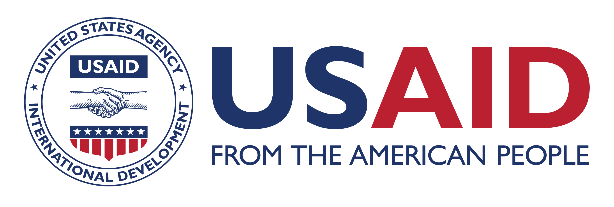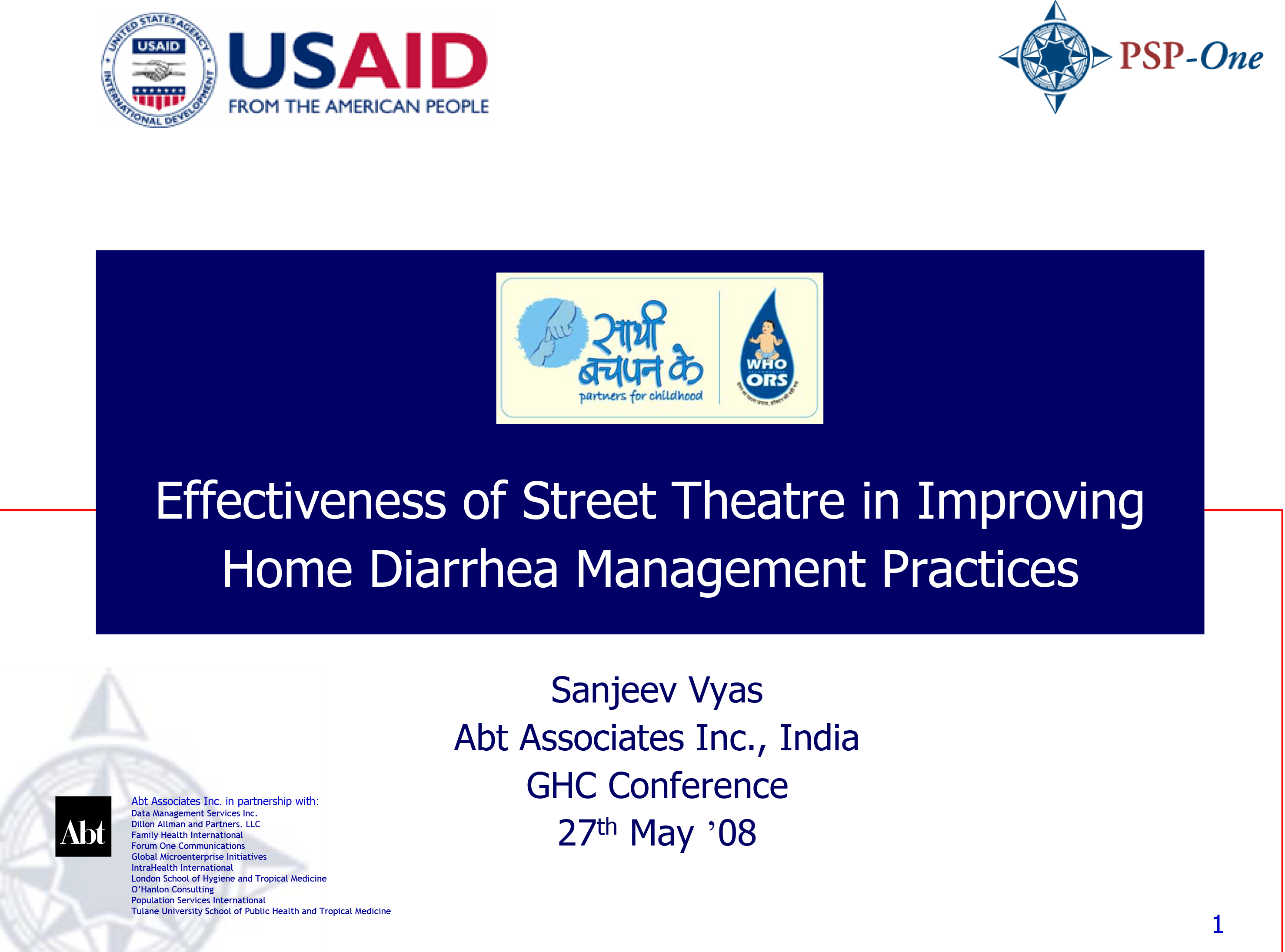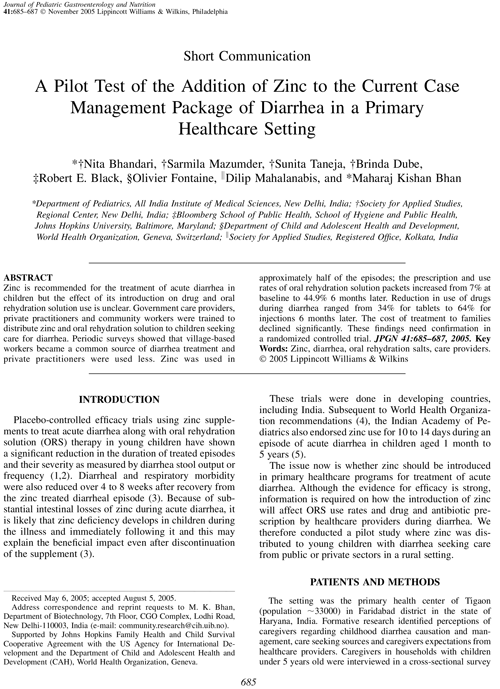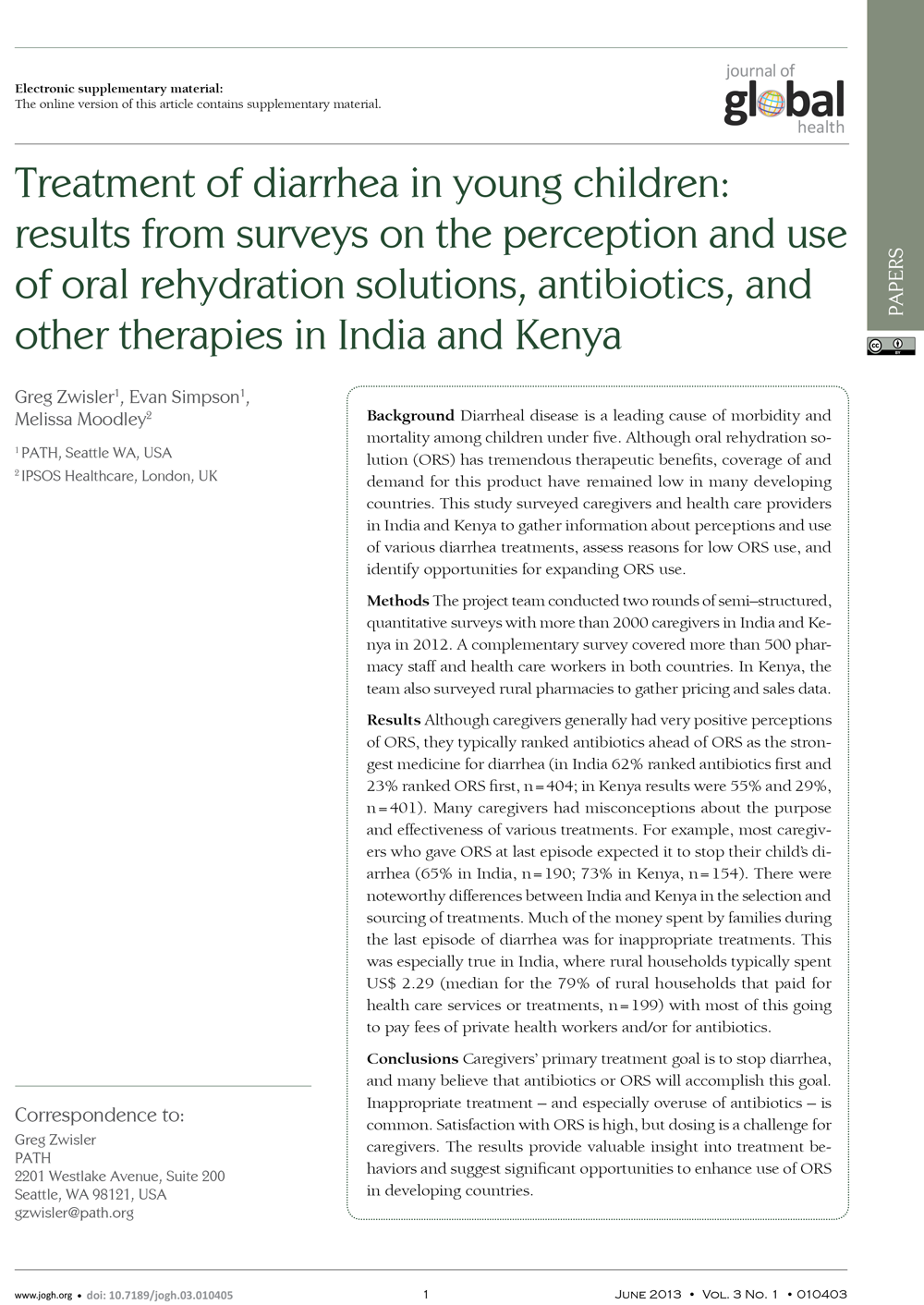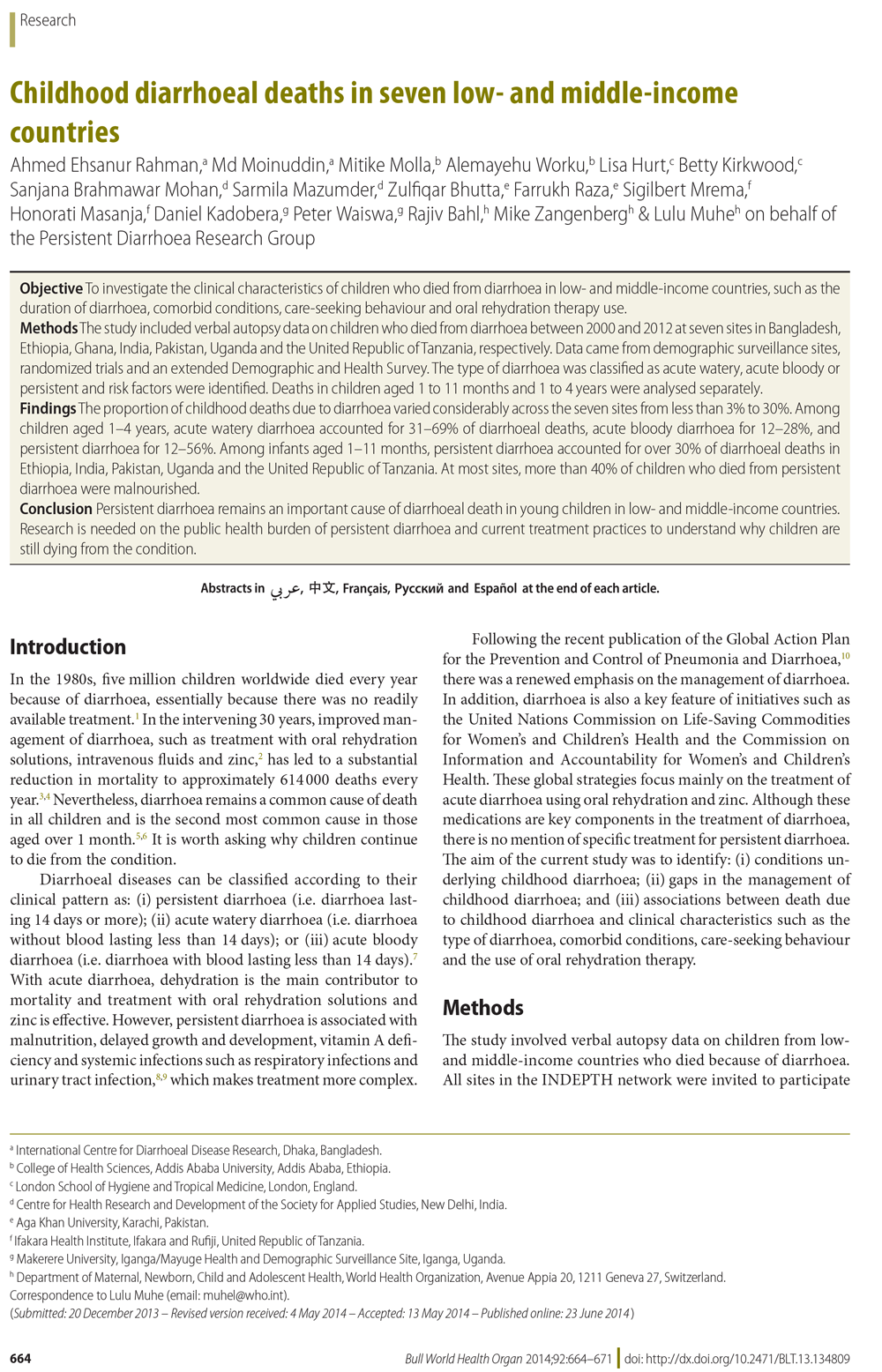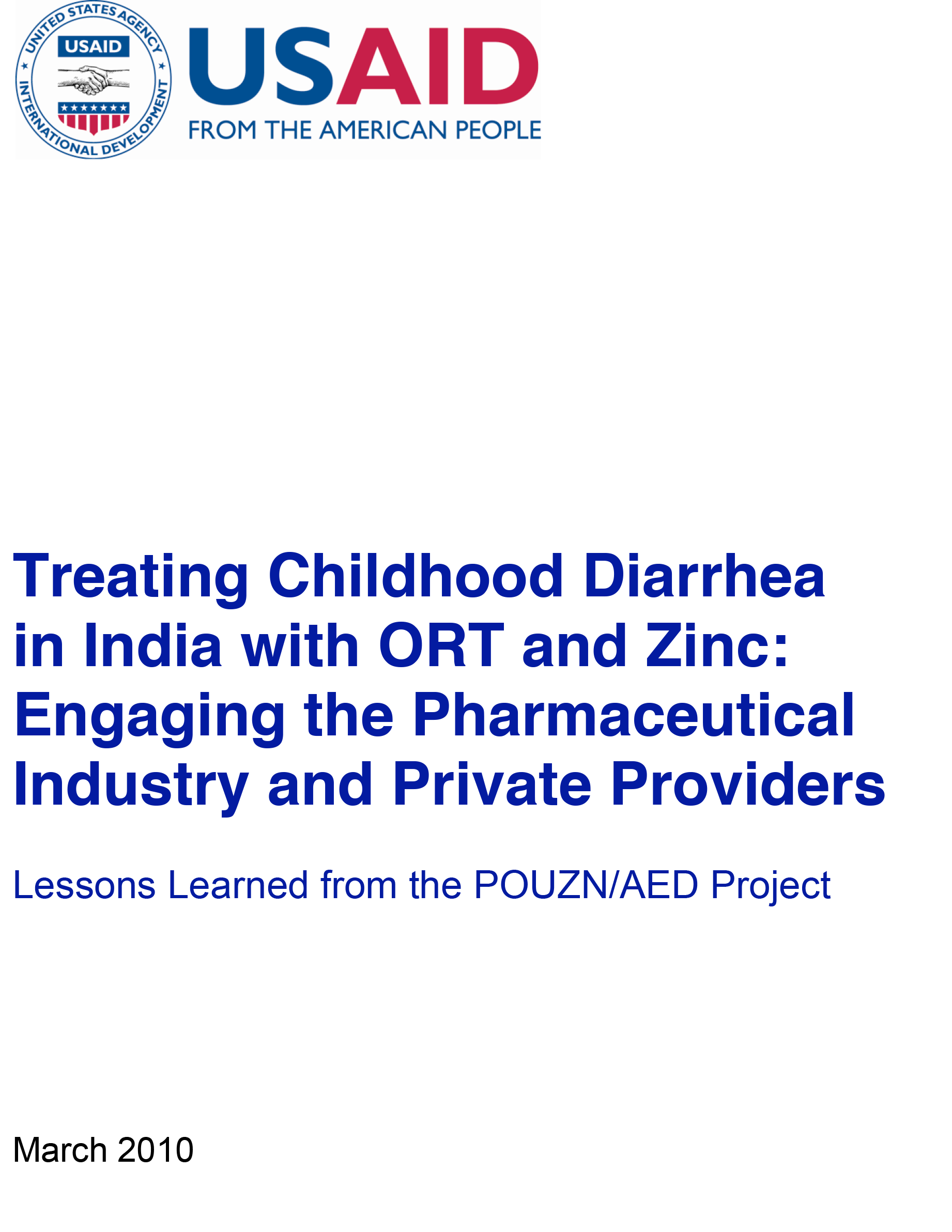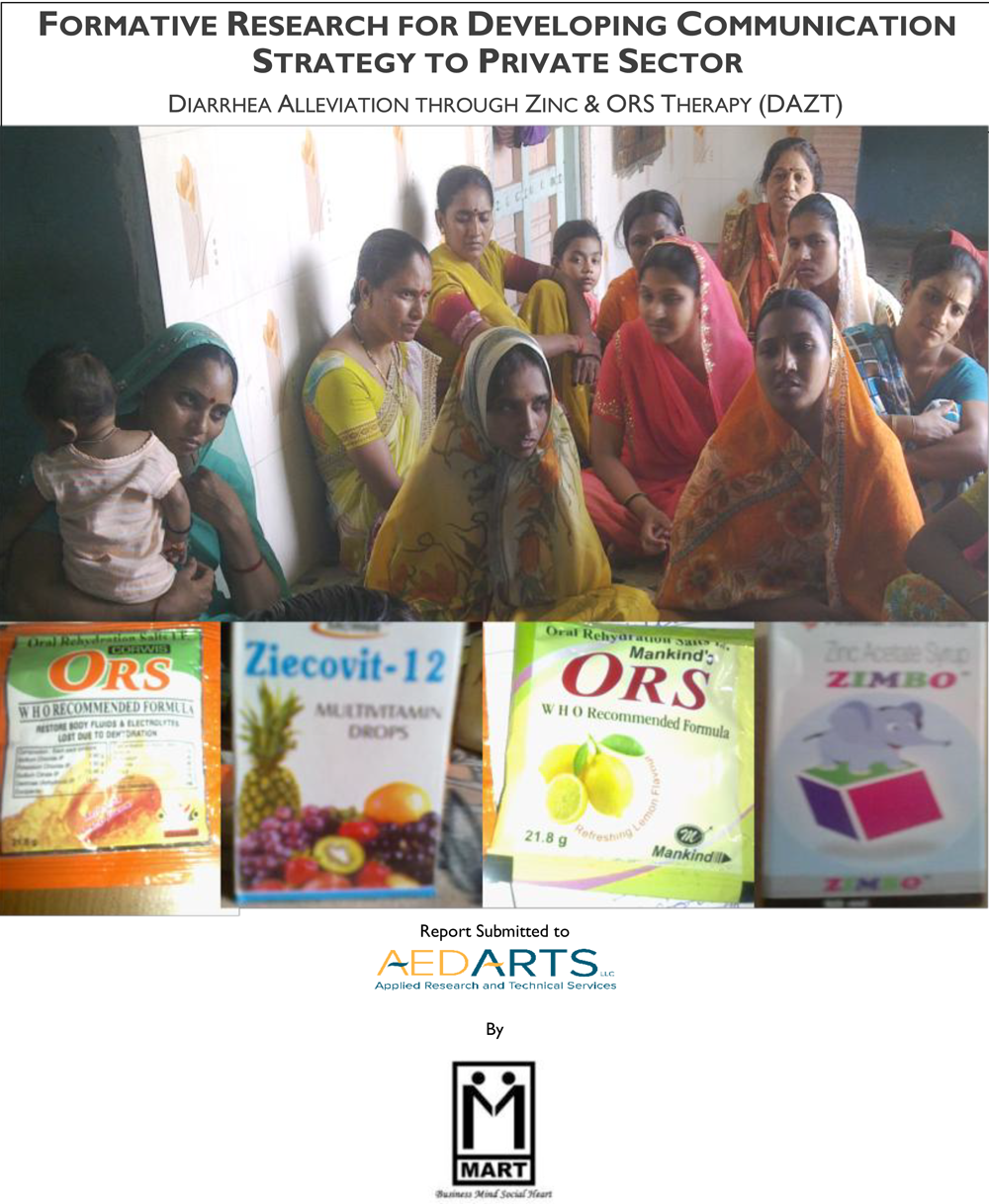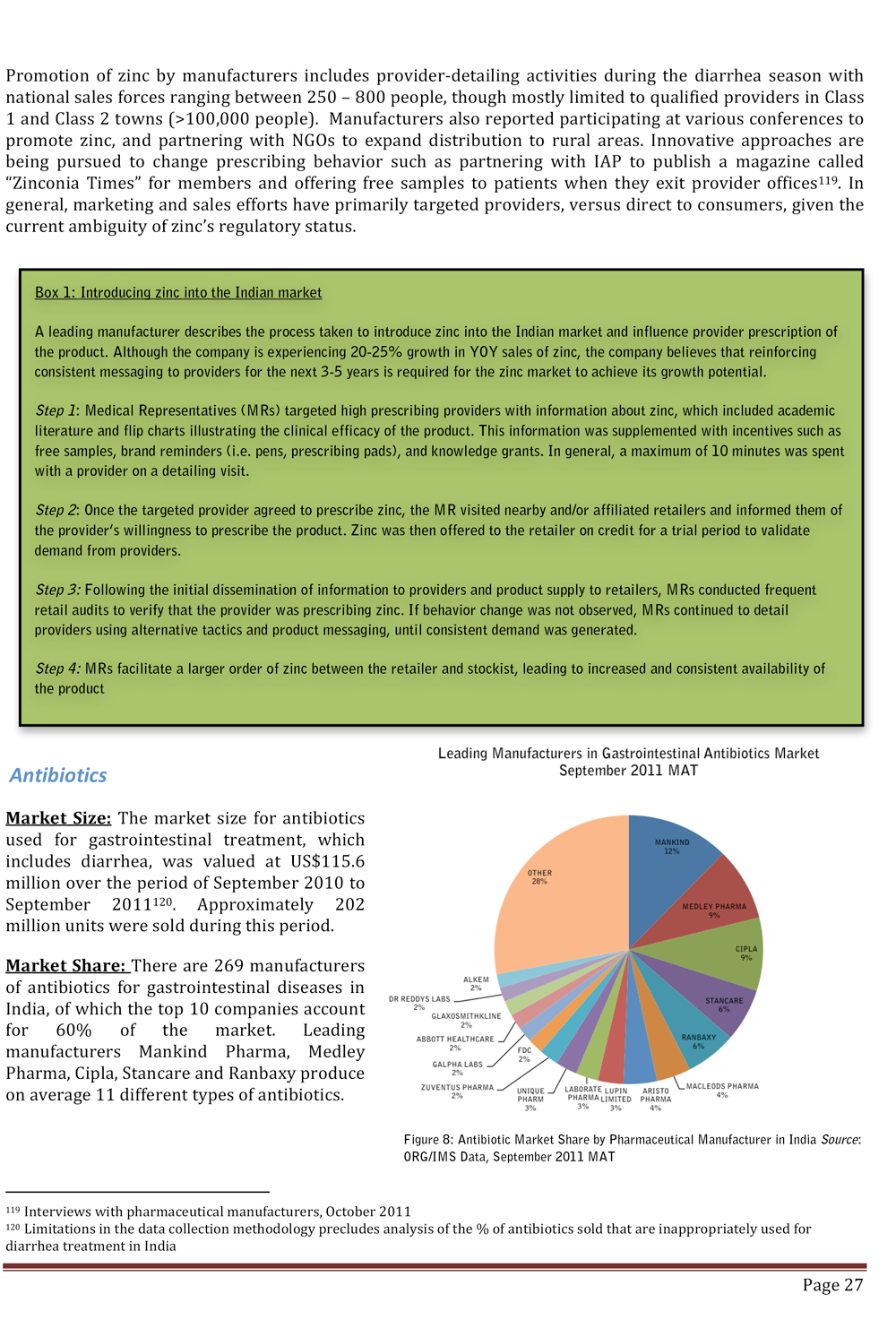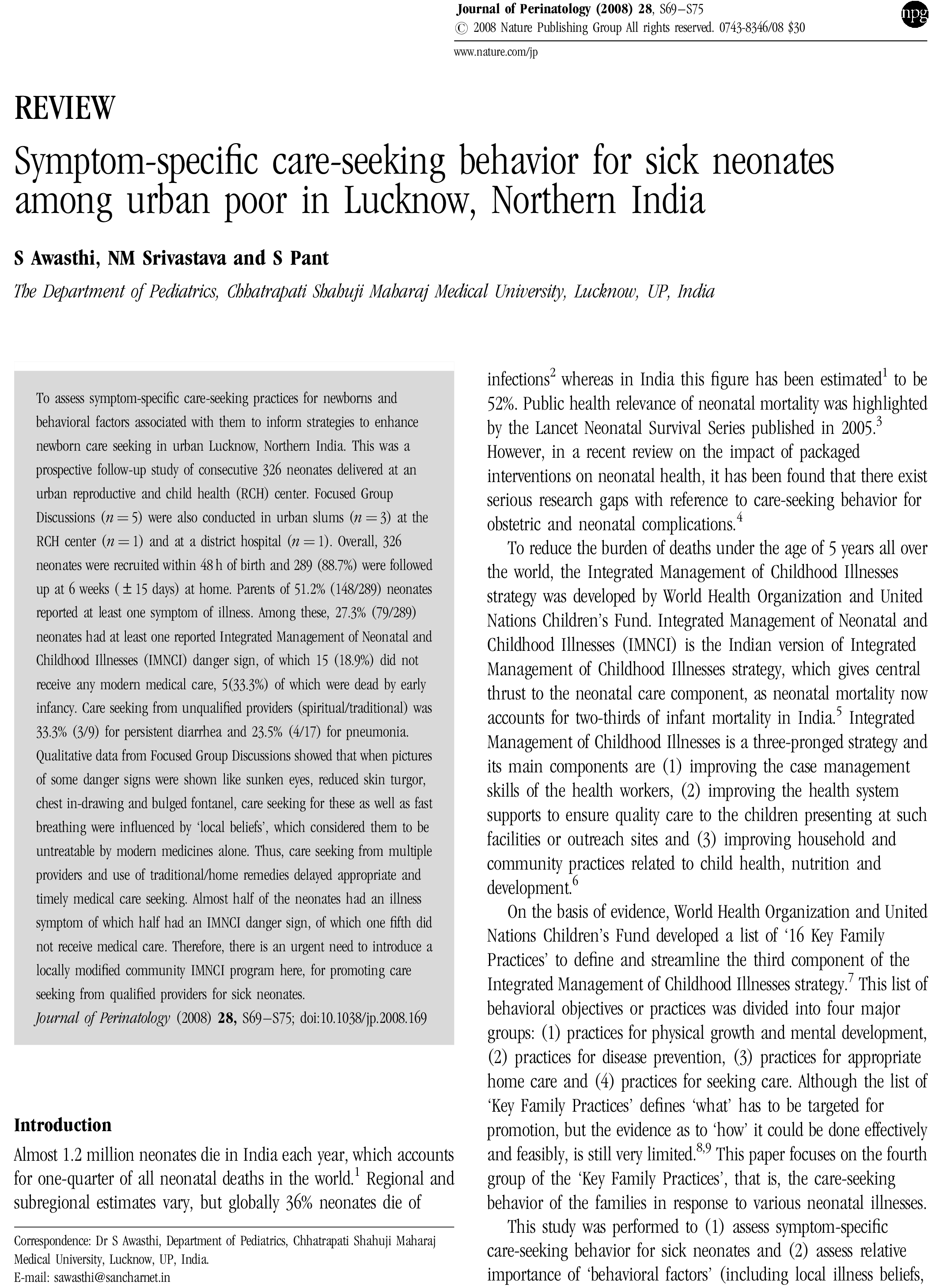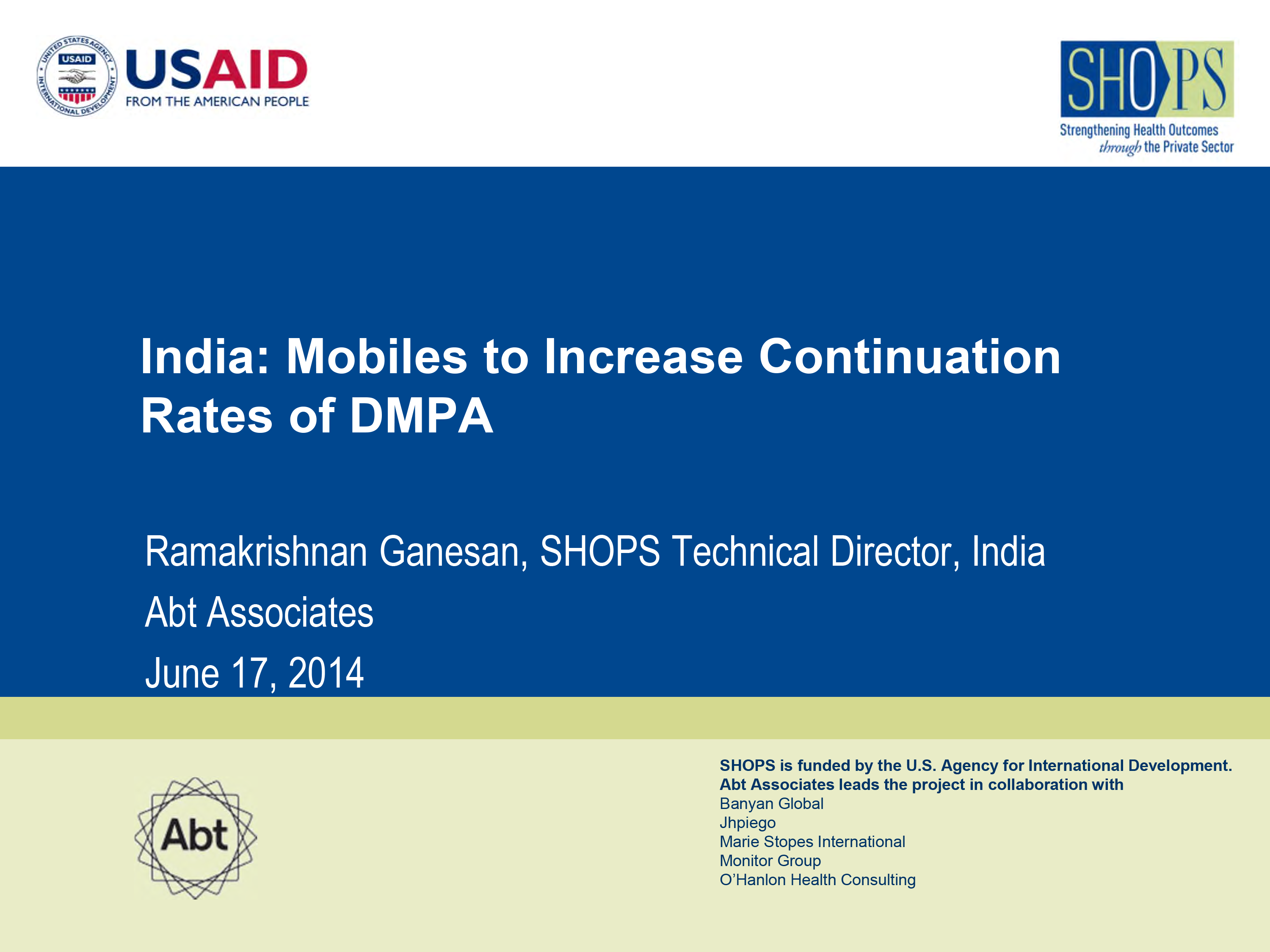
Resource Library
Effectiveness of Street Theatre in Improving Home Diarrhea Management Practices
In India, childhood diarrhea is the second leading cause of death in children under five. Although ORS is widely available and affordable and there is high awareness of the product, there is relatively low use of ORS. Only 20% of caregivers give ORS in and 18% of doctors prescribe ORS in North India. The program objectives were to promote the increased use of ORS in cases of childhood diarrhea and to encourage manufacturers, doctors, and chemists to shift to making and prescribing low-osmolarity ORS.
Because conventional mass media had been inefficient in North India in past programs, this program used community outreach to promote ORS use. The interventions used were Nukkad Nataks, or street theater shows that delivered key messages, trainings of slum ISMP doctors in the community, and wall paintings of key messages in the slums.
The study found that the Nukkad Natak shows led to significant change in knowledge and use of ORS among caregivers. The reach of Nukkad Natak in urban slums was 34% compared to between 16 to 2% reach of TV, Radio and Press.
Resource Type : Presentation
Country : India
Year : 2008-05-27T00:00:00
Language : English
Project : SHOPS

Resource Library
A Pilot Test of the Addition of Zinc to the Current Case Management Package of Diarrhea in a Primary Healthcare Setting
Zinc is recommended for the treatment of acute diarrhea in children but the effect of its introduction on drug and oral rehydration solution use is unclear. Government care providers, private practitioners and community workers were trained to distribute zinc and oral rehydration solution to children seeking care for diarrhea. Periodic surveys showed that village-based workers became a common source of diarrhea treatment and private practitioners were used less. Zinc was used in approximately half of the episodes; the prescription and use rates of oral rehydration solution packets increased from 7% at baseline to 44.9% 6 months later. Reduction in use of drugs during diarrhea ranged from 34% for tablets to 64% for injections 6 months later. The cost of treatment to families declined significantly. These findings need confirmation in a randomized controlled trial.
Resource Type : Other
Country : India
Year : 2005-11-01T00:00:00
Language : English
Project : SHOPS

Resource Library
Treatment of diarrhea in young children: results from surveys on the perception and use of oral rehydration solutions, antibiotics, and other therapies in India and Kenya
The objective of this study was to investigate the clinical characteristics of children who died from diarrhea in low- and middle-income countries, such as the duration of diarrhoea, comorbid conditions, care-seeking behavior and oral rehydration therapy use. The study included verbal autopsy data on children who died from diarrhea between 2000 and 2012 at seven sites in Bangladesh, Ethiopia, Ghana, India, Pakistan, Uganda and the United Republic of Tanzania, respectively. Data came from demographic surveillance sites, randomized trials and an extended Demographic and Health Survey. The type of diarrhea was classified as acute watery, acute bloody or persistent and risk factors were identified. Deaths in children aged 1 to 11 months and 1 to 4 years were analyzed separately. Findings revealed that the proportion of childhood deaths due to diarrhea varied considerably across the seven sites from less than 3% to 30%. Among children aged 1–4 years, acute watery diarrhea accounted for 31–69% of diarrheal deaths, acute bloody diarrhea for 12–28%, and persistent diarrhea for 12–56%. Among infants aged 1–11 months, persistent diarrhea accounted for over 30% of diarrheal deaths in Ethiopia, India, Pakistan, Uganda and the United Republic of Tanzania. At most sites, more than 40% of children who died from persistent diarrhea were malnourished. Persistent diarrhea remains an important cause of diarrheal death in young children in low- and middle-income countries. Research is needed on the public health burden of persistent diarrhea and current treatment practices to understand why children are still dying from the condition.
Resource Type : Brief
Country : India, Kenya
Year : 2013-06-01T00:00:00
Language : English
Project : SHOPS

Resource Library
Childhood diarrheal deaths in seven low-and middle-income countries
The objective of this study was to investigate the clinical characteristics of children who died from diarrhea in low- and middle-income countries, such as the duration of diarrhoea, comorbid conditions, care-seeking behavior and oral rehydration therapy use. The study included verbal autopsy data on children who died from diarrhea between 2000 and 2012 at seven sites in Bangladesh, Ethiopia, Ghana, India, Pakistan, Uganda and the United Republic of Tanzania, respectively. Data came from demographic surveillance sites, randomized trials and an extended Demographic and Health Survey. The type of diarrhea was classified as acute watery, acute bloody or persistent and risk factors were identified. Deaths in children aged 1 to 11 months and 1 to 4 years were analyzed separately. Findings revealed that the proportion of childhood deaths due to diarrhea varied considerably across the seven sites from less than 3% to 30%. Among children aged 1–4 years, acute watery diarrhea accounted for 31–69% of diarrheal deaths, acute bloody diarrhea for 12–28%, and persistent diarrhea for 12–56%. Among infants aged 1–11 months, persistent diarrhea accounted for over 30% of diarrheal deaths in Ethiopia, India, Pakistan, Uganda and the United Republic of Tanzania. At most sites, more than 40% of children who died from persistent diarrhea were malnourished. Persistent diarrhea remains an important cause of diarrheal death in young children in low- and middle-income countries. Research is needed on the public health burden of persistent diarrhea and current treatment practices to understand why children are still dying from the condition.
Resource Type : Brief
Country : Bangladesh, Ethiopia, Ghana, India, Pakistan, Tanzania, Uganda
Year : 2014-06-23T00:00:00
Language : English
Project : SHOPS

Resource Library
Treating Childhood Diarrhea in India with ORT and Zinc: Engaging the Pharmaceutical Industry and Private Providers
Zinc is widely recognized as a highly effective and inexpensive way to treat childhood diarrhea. In 2005, USAID created the Point-of-Use Water Disinfection and Zinc Treatment (POUZN) Project and contracted with AED to introduce zinc in combination with Oral Rehydration Therapy (ORT) in India. This case study provides the context for and goals of the project; the various phases of POUZN; and strategy adjustments. It looks to the future for next steps and summarizes the principle lessons learned during the project.
The following lessons may prove useful for further work in India, as well as be adaptable to other countries:
- Zinc treatment is a new concept and competes with well-entrenched prescription behaviors and traditional treatment practices.
- Key opinion leaders in both the public and the private sector (including top pediatricians) are crucial zinc champions.
- Working with the private pharmaceutical sector is critical to ensure a long-term, competitively priced supply of zinc and sustained demand generation.
- The reach of pharmceutical marketing (and "detailing") is limited in rural areas, and the "trickle down"
- The public and private sectors have different objectives and time scales.
Resource Type : Report
Country : India
Year : 2010-03-01T00:00:00
Language : English
Project : SHOPS

Resource Library
Formative Research for Developing Communication Strategy to Private Sector
This Report presents the findings of the formative research conducted in the states of UP and Gujarat to understand the underlying needs of the community, their health seeking behaviour and practices in terms of childhood diarrhea treatment and influences and triggers to adopt ORS and Zinc supplements as the solution. The report is based on data collected from the field through focus group discussions and in-depth interviews with mothers/caregivers of children under five years of age, health service providers like Rural Medical Practitioners, General Physicians and Pediatricians and drug store owners in the villages of UP and Gujarat. At the end, the study provides a cue on the possible communication approach and tools that could be used to reach the target audience in the near future.
Resource Type : Report
Country : India
Year : 2011-01-01T00:00:00
Language : English
Project : SHOPS

Resource Library
The Private Sector Market for Diarrhea Treatment in India
Improving use of zinc and ORS for treatment of childhood diarrhea presents a significant opportunity to accelerate the reduction of child mortality in India in support of the achievement of Millennium Development Goal 4 and to expand the value of the ORS and zinc market. This assessment contributes to this end by examining the diarrhea treatment market in a way that offers strategic direction for the development of India’s essential medicines national strategy.
Primary and secondary data collection was conducted between September 2011 and January 2012, which included semi‐structured interviews with key informants operating at different levels of the supply chain, a field visit to an international NGO’s project site in Lucknow, Uttar Pradesh and a desk review of existing qualitative and quantitative research, and population‐based data.
The study found the following barriers to ORS and zinc use:
- Low awareness of zinc as the recommended treatment for diarrhea and poor perceptions of ORS as an effective diarrhea treatment
- The profitability and affordability of ORS and zinc is not as competitive as alternative treaments
- The market for ORS and zinc in India is largely controlled by five companies which do not have the resources needed to shift the market from antibiotics to ORS and zinc
- Zinc is not considered an Over-The-Counter product so direct to consumer marketing and distribution is limited
Resource Type : Report
Country : India
Year : 2012-04-01T00:00:00
Language : English
Project : SHOPS

Resource Library
Symptom-specific care-seeking behavior for sick neonates among urban poor in Lucknow, Northern India
To assess symptom-specific care-seeking practices for newborns and behavioral factors associated with them to inform strategies to enhance newborn care seeking in urban Lucknow, Northern India. This was a prospective follow-up study of consecutive 326 neonates delivered at an urban reproductive and child health (RCH) center. Focused Group Discussions (n¼5) were also conducted in urban slums (n¼3) at the RCH center (n¼1) and at a district hospital (n¼1). Overall, 326 neonates were recruited within 48 h of birth and 289 (88.7%) were followed up at 6 weeks (±15 days) at home. Parents of 51.2% (148/289) neonates reported at least one symptom of illness. Among these, 27.3% (79/289) neonates had at least one reported Integrated Management of Neonatal and Childhood Illnesses (IMNCI) danger sign, of which 15 (18.9%) did not receive any modern medical care, 5(33.3%) of which were dead by early infancy. Care seeking from unqualified providers (spiritual/traditional) was 33.3% (3/9) for persistent diarrhea and 23.5% (4/17) for pneumonia. Qualitative data from Focused Group Discussions showed that when pictures of some danger signs were shown like sunken eyes, reduced skin turgor, chest in-drawing and bulged fontanel, care seeking for these as well as fast breathing were influenced by ‘local beliefs’, which considered them to be untreatable by modern medicines alone. Thus, care seeking from multiple providers and use of traditional/home remedies delayed appropriate and timely medical care seeking. Almost half of the neonates had an illness symptom of which half had an IMNCI danger sign, of which one fifth did not receive medical care. Therefore, there is an urgent need to introduce a locally modified community IMNCI program here, for promoting care seeking from qualified providers for sick neonates.
Resource Type : Brief
Country : India
Year : 2008-01-01T00:00:00
Language : English
Project : SHOPS

Resource Library
India: Mobiles to Increase Continuation Rates of DMPA
This study analyzed the effects of telephonic follow-up to reduce contraceptive discontinuation, specifically for the injectable DMPA. The pilot test demonstrated a clear dose-response relationship, where trained counselor follow-ups by phone positively impacted DMPA continuation rates. The presentation was made by Ramakrishnan Ganesan at the mHealth in the SHOPS Project: Case Studies and Lessons Learned special event at the Ronald Reagan Building in June 2014.
Resource Type : Presentation
Country : India
Year : 2014-06-18T00:00:00
Language : English
Project : SHOPS

Resource Library
Les téléphones mobiles améliorent les résultats de santé
Mobile phone subscriptions now top six billion, with 76 percent of users living in the developing world. With the rapid growth of mobile phones in developing countries, there is an unprecedented opportunity to support health care providers and share lifesaving health information with isolated populations. Health projects can incorporate mobile phones in a range of promising applications: to deliver behavior change messages that improve awareness and reinforce healthy behaviors, to support health providers with portable tools, and to strengthen an organization’s management and systems. The SHOPS project has been a leader in designing and evaluating mobile applications to improve health.
Resource Type : Brief
Country : Bangladesh, Ghana, India
Year : 2014-04-15T00:00:00
Language : French
Project : SHOPS
Pagination
- Previous page
- Page 7
- Next page

